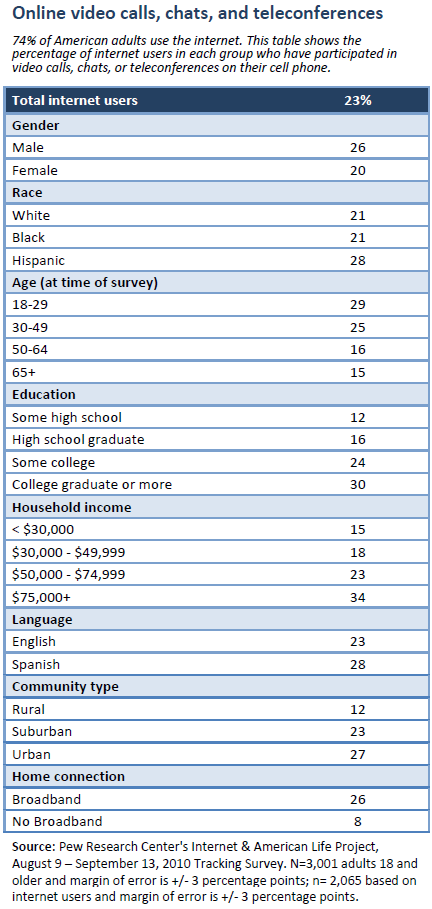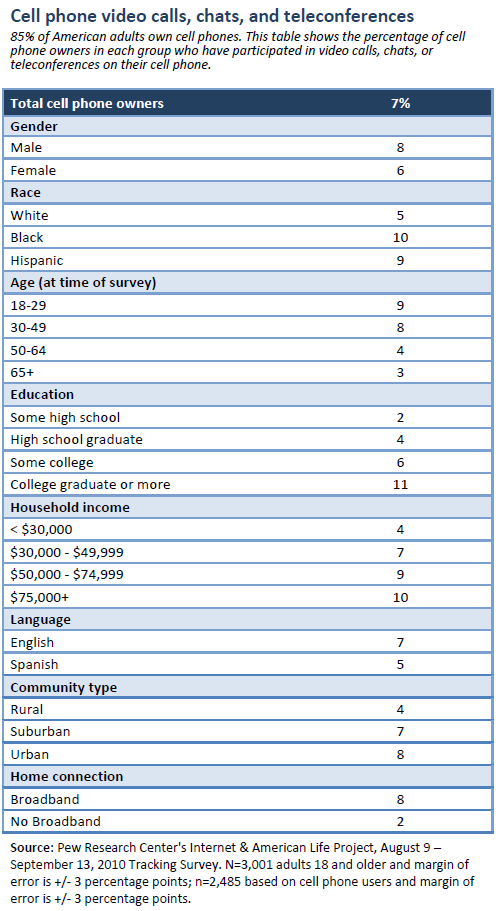19% of Americans have tried video calls or video chat or teleconferencing online and on cell phones
Almost a fifth of American adults – 19% – have tried video calling either online or via their cell phones. That figure comes from adding up the number of adults who said they either had made a video or teleconferencing call online (17% of adults have done that) or made video calls on their cell phones (6% of adults have done that). In many cases people have placed video calls on both the internet and their cell phone. Those who answered yes to both questions were only counted once in the overall tally of video callers.
These figures translate into 23% of internet users and 7% of cell phone owners who have participated in video calls, chats, or teleconferences.
These figures were gathered in a survey of 3,001 American adults (age 18 and older) between August 9 and September 13, 2010. The margin of error is +/- 3 percentage points.
This is the first survey of the Pew Research Center’s Internet & American Life Project that has covered both online and cell-phone video calls, so there are no prior comparable data to show how much the activity is increasing. In the internet realm, the video-calling has risen modestly from 20% of internet users in April 2009 to 23% of internet users in the summer 2010 survey. On any given day, 4% of internet users are participating in video calls, video chat, or teleconferencing, up from 2% in April 2009.
Some of the key findings in the most recent survey related to online video calls, which are conducted by 23% of the adults who are internet users:
- Video calling online is especially appealing to upscale users. A third of internet users (34%) living in households earning $75,000 or above have participated in such calls or chats, compared with 18% of those earning less than $75,000.
- Younger internet users are considerably more likely to conduct video calls. Some 29% of the internet users ages 18-29 have participated in video calls or chats or teleconferences, compared with 15% of internet users age 65 or older.
- Online men are more likely than online women to participate in online video calls (26% vs. 20%).
- Urban internet users (27%) and suburban users (23%) are significantly more likely than rural users (12%) to have participated in video calls, chats, or teleconferences.
- On a typical day, 4% of internet users participate in video calls, chats, or teleconferences. That is a uptick from the Project’s April 2009 survey, when 2% of internet users reported participating in online video exchanges.
Some of the key findings in the most recent survey related to video calls on cell phones, which are conducted by 7% of the adults who cell phone owners:
- Cell-owning blacks are more likely than whites to participate in video calls, chats, or teleconferences (10% vs. 5%).
- Those in upper-income households are more likely than others to participate in video calls (10% of cell owners in households earning over $75,000 participate in such calls, compared to 6% who live in households earning less than $75,000.
- Cell owners under age 50 are more likely than those over age 50 to have participated in such video calls (8% vs. 4%).
Video calling: Background
Video calling has become increasingly available as camcorders have spread through the online environment, cameras have been built into smart phones, and as video-chat services like Skype, Google Talk, and Apple iChat have become a feature of the online and smart phone environment. Teleconferencing is also becoming more embedded in the business environment.
This summer, in a nationally-representative telephone survey using landlines and cell phones, the Pew Research Center’s Internet & American Project asked for the first time about the prevalence of video calling both online and on cell phones.
The survey of 3,001 adults found that 74% of American adults are internet users and, among those internet users, 23% have participated in video calls, chats, or teleconferences. The survey also found that 85% of American adults have cell phones and, among those cell owners, 7% have used their phones for video calls, chats, or teleconferences. Overall, that means that 19% of Americans have either used the internet or their cell phone to participate in video calls – and in many cases, people have used both technologies for video chats.
Internet-based video calls, chats, teleconferences
In April 2009, the Pew Internet Project asked internet users about video calls and found at the time that 20% of them had participated in such calls. So, there has been a slight uptick in the number of Americans who use the internet for video calling – from 20% in April 2009 to 23% in the summer 2010 survey. The Project’s survey also asked people if they had participated in such calls “yesterday” and the surveys show that the percentage of video callers online on any given day rose from 2% in April 2009 to 4% in the summer of 2010.
The following table gives a breakdown of the demographic differences among internet users when it comes to video calling, chatting, or teleconferencing.

Cell phone use for video calls, chats, teleconferences
For the first time, Pew Internet asked cell phone owners about video calls, chats, and teleconferences and found that 7% of cell owners have taken advantage of that feature. Video activities are far less common than other cell features. For instance, in the same survey, Pew Internet found that 74% of cell owners use text messaging features, 39% use their phones to access the internet, 34% use them for email, and 30% use them for instant messaging.
The following table gives a breakdown of the demographic differences among cell owners when it comes to video calling, chatting, or teleconferencing.





